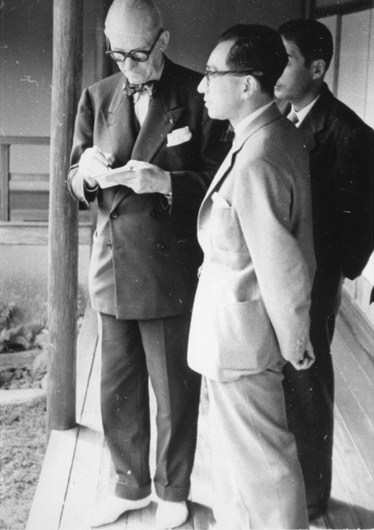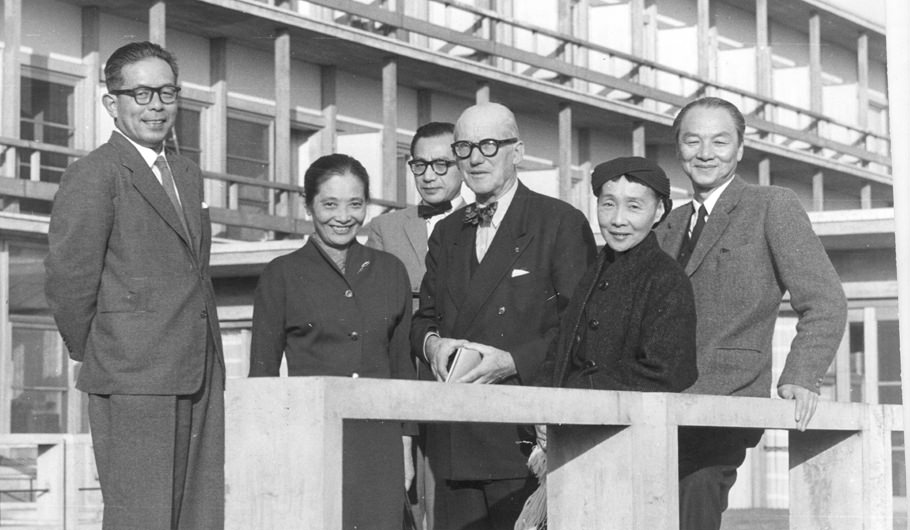Since the 1920s, the history of architecture and of the city in Japan have remained closely linked to Le Corbusier’s work and thought. The first article on Le Corbusier to appear was written by the architect KazueYakushiji for the journal Kenchiku Sekai (The World of Architecture) in August 1923.
When Tokyo was devastated by the great earthquake of 1 September 1923, it was in Le Corbusier’s precepts that inspiration for solutions to urban reconstruction issues was sought. Thus, in 1924, the architect Junpei Nakamura published the book Tokyo Reconstruction Plan 1924 as well as articles in which he presented Le Corbusier’s Plan for a Contemporary City of 3 Million Inhabitants and some of the ideas from his book Towards an architecture.
After reading the book Towards an architecture in 1924, another architect, Kenji Imai in 1926 undertook a trip to Europe, where he visited Gropius in Germany and Le Corbusier in Paris. Seigo Motono (1882-1944), an architect and founder in 1927 of the the International Architectural Association of Japan, had in 1923 already learned of Le Corbusier’s Plan for a Contemporary City Of 3 Million Inhabitants.
But above all it was Hideto Kishida, a lecturer at Tokyo University Department of Architecture, who lectured on Le Corbusier and lent works by Le Corbusier he had brought back from Europe in 1926 to a student of his who knew French, Kunio Mayekawa (1905-1986).
The first Japanese translations of Le Corbusier appeared between 1928 and 1929 in the journal Kokusai Kenchiku. The journal devoted two special issues to Le Corbusier expressing all-out enthusiasm.
In 1929 the publisher Koseisha Shobo published in Japanese the complete texts of Towards
an Architecture and in 1931 Today’s Decorative Art.
In the 1930s, Japanese architects, whose enthusiasm for Le Corbusier was to continue, erected a large number of buildings on the lines of Le Corbusier’s precepts. More than a hundred of these realizations can be found presented in Japanese architecture magazines of the 1930s. In an article published in a French magazine, BrunoTaut, invited to Japan in 1932 by the “International Architectural Association of Japan” emphasized how Le Corbusier fascinated Japan, even eclipsing the influence of Frank Lloyd Wright. He gave as examples the architects Antonin Raymond and KamekiTsuchiura.
Until World War II, there were no less than four Japanese co-workers in the studio in rue de Sèvres.
The first of these, Kunio Mayekawa, much impressed by Le Corbusier’s texts, presented a dissertation on Le Corbusier for his degree in architecture. Upon graduating in 1928, he was to work for two years in the Paris studio, becoming Le Corbusier’s first Japanese colleague.
On his return to Japan in April 1930, Mayekawa joined Antonin Raymond’s studio in August 1930 and continued to spread Le Corbusier’s ideas,translating into Japanese excerpts from Today’s Decorative Art. In 1932 Mayekawa in a personal capacity executed a building for the Kimura industrial laboratories, a work directly inspired by Le Corbusier. In 1935 he opened his own agency which was to produce other important architects of the modern Japanese movement such as: KenzoTange, Masato Ohtaka,Toshihiko Kimura and Azusa Kitou.
Arriving a month and a half after Mayekawa at the studio in rue de Sèvres, another pupil of Hideto Kishida, Kikunosuke Makino (1903-1983), who had graduated in 1927, stayed for only eight months. On his return to Japan, he published articles and translations describing life in Le Corbusier’s studio.
Nagatoshi Tsuchihashi was the third Japanese architect to work with Le Corbusier. He entered the studio in 1929 but for health reasons was obliged to return to Japan in February 1930. He nonetheless published articles in Japanese journals describing life in Le Corbusier’s studio.
Lastly, Junzo Sakakura (1904-1969), who graduated in 1927, met Le Corbusier in 1929 and joined his studio in 1931. Sakakura remained there for five years, reaching the position of Head of Agency. Returning to Japan in 1936, he was chosen to be the architect of the Japan Pavilion for the 1937 International Exhibition in Paris. This pavilion directly incorporated the principles developed in Le Corbusier’s “Museum of Unlimited Growth”. Sakakura extended his stay in Paris and resumed collaboration with Le Corbusier participating in the fifth CIAM Congress. Back in Japan in 1939, he set up his own agency. In 1940, he invited Charlotte Perriand to Japan and organized a furniture design exhibition.
Publications dealing with Le Corbusier diminished during the war years, but their number still remained significant. The competition in 1942 for the “Greater East Asia Co-Prosperity Sphere Memorial Hall” showed Le Corbusier’s influence, several of the proposals resembling his project for the Mundaneum (1929).
Kenzo Tange (1913-2005) a major figure in the world of Japanese architecture, was one of the architects who, without having worked directly with Le Corbusier, were largely inspired by his works. As is known, his vocation was revealed to him by reading Le Corbusier’s writings.The urban development projects forTokyo proposed byTange between 1959 and 1961 are representative of this influence. It was as a professor in the Department of Architecture at the University of Tokyo that he was to create the Department of Urbanism. He transmitted Le Corbusier’s ideas to his students, the best known of whom were Sachio Ohtani, Fumihiko Maki, Kisho Kurokawa and Arata Isozaki. In 1955, he designed the Peace Centre in Hiroshima, which is clearly inspired by Le Corbusier. Most of Tange’s projects show the influence of Le Corbusier and of the CIAM Congresses, including the projects for the Prefecture ofTokyo Metropolis (1957) and the Kagawa Prefecture (1958), which were the models for all public administrative buildings built in Japan after the war. The spread of Le Corbusier’s ideas in postwar Japan was favoured by Junzo Sakakura who in 1955 organized the exhibition “Proposal for a synthesis of the arts, Paris 1955: Le Corbusier, Fernand Léger, Charlotte Perriand”. In 1956 he made a stage curtain for the Tokyu Bunkakaikan (Tokyo Cultural Centre) from an original cartoon by Le Corbusier and published translations of L’Unité d’habitation de Marseille and Manières de penser l’urbanisme. In 1964, he published the critical biography Le Corbusier, a Precursor of Modern Art.
From 1950 to 1952, another Japanese architect Takamasa Yoshizaka, a lecturer at Waseda University, worked in Paris with Le Corbusier on various projects. A fluent French speaker, he translated important works such as La Charte d’Athènes in 1953, Le Modulor, Vers une architecture, and finally in 1978 he completed the translation of the Complete Works.
If the work of Mayekawa always reflects the influence of Le Corbusier’s 1920s period, after the war the industrialization of construction methods and materials was to be an omnipresent concern in his work. As for Sakakura, Le Corbusier’s influence can be seen in major postwar work such as the Kamakura Museum (1951) which, down to the the building methods adopted, incorporates the ideas of the “Museum of Unlimited Growth”, developed by Le Corbusier in the 1930s.
The Musée National des Beaux-Arts de l’Occident was executed, with the assistance of Yoshizaka, Mayekawa and Sakakura, according to the same principles of construction. This is the iconic symbol of Le Corbusier’s influence in Japan. In 1961, theTokyo theatre (Tokyo Bunka Kaikan) built by Mayekawa just opposite the Musée National des Beaux- Arts de l’Occident, put the finishing touch to this series of buildings reflecting Le Corbusier’s influence in Japan.
We may say that the continuing fascination exercised by Le Corbusier in Japan from the beginning of the 1920s was not only aesthetic, but changed lifestyles and particularly research in the fields of the industrialization of housing and urbanism.



